XFX’s Radeon HD 5770, A Look At The 5770 Revision 2 Cooler
by Ryan Smith on January 5, 2010 12:00 AM EST- Posted in
- Ryan's Ramblings
From our Radeon HD 5770 Review:
Interestingly enough, we’ve been told that the Phoenix shroud isn’t going to be sticking around for long. The first wave of cards launching today and for the near future will be using the shroud, but once AMD’s vendors begin using their own designs, AMD doesn’t expect most of the vendors to stick with the shroud. XFX has specifically been named as a party that will keep using the shroud on products, but anyone else is subject to change. With a TDP of only 108W, the Phoenix shroud is probably overbuilt and certainly more expensive than vendors would like, where mainstream products come with thinner margins. We would expect the vendors that do switch to move to more traditional dual-slot coolers, likely ones that aren’t shrouded at all and would not blow hot air outside of the case.
What AMD explained to us quickly came to pass, and once the first wave of 5770s sold out, the replacement waves started coming with coolers besides the Phoenix shroud. Since then we’ve had a number of people ask us how the later coolers compare to the Phoenix, and this is something that we can finally answer today.
XFX's 5770 Rev 2
XFX – who AMD named as one of the companies who would be selling the Phoenix along with other cooler designs – was kind enough to send over one of their alternative 5770 models for this cooler evaluation. Our particular interest in this card is that it uses the same egg-shrouded cooler that is appearing on the majority of 5770s seen in retail, making it the de-facto standard 5770 cooler. For the sake of simplicity, we are calling this the 5770 Revision 2 cooler. In XFX’s case, this is sold alongside cards using the Phoenix and another card using an open cooler similar to the Rev 2.
When first looking at the Rev 2, looks can be deceiving. While it does use an egg-shaped shroud very similar to that found on the 5750, the actual HSF unit is entirely different, making the similarities merely superficial. Ultimately the 5750’s HSF was a simple aluminum heatsink sitting on top of the GPU, with a fan sitting on top of the heatsink. For the 5770, a much more elaborate HSF is used, consisting of a copper block with a pair of heatpipes embedded. These heatpipes then run the entire circumference of a circular aluminum heatsink that sits on top of the copper block. Finally, sitting in the middle of the heatsink (and not above it) is the fan.

A side view of the Rev 2 cooler
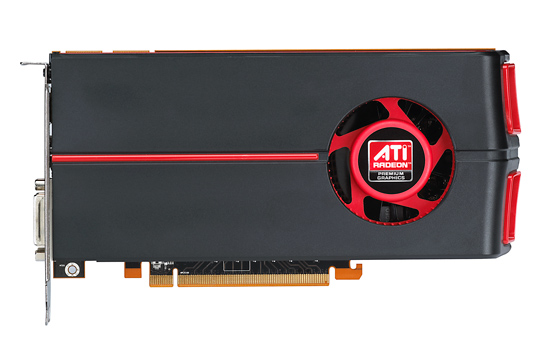
The original Phoenix cooler
In short, in spite of the visual similarities to the 5750’s cooler, the Rev 2 cooler entails a much larger heatsink using heatpipes and better fan placement. If you’ve ever seen Zalman’s VF900 GPU cooler, then the design is very similar to that.

Overall the Rev 2 is very similar to the Zalman VF900 (image courtesy Zalman)
With the change in coolers comes some space savings for the card. As the Phoenix shroud added another half-inch to the total length of the 5770, it pushed an 8.25” design out to 8.75”. With the Rev 2 cooler there is no overhang, bringing the card in at just the PCB length of 8.25”. This also means that the 6-pin PCIe power plug is no longer partially hidden by the shroud, making it easily accessible on the Rev 2.
We should note that while the cooler has changed, the PCB has not. The PCB on this card is exactly identical to the PCB on our 5770 reference card. In fact the only difference besides the cooler is the use of Samsung GDDR5 rather than Hynix GDDR5. In benchmarks there is absolutely no difference in performance between our Rev 2 card and our original reference card. So the only practical difference is the cooler.
That brings us to what kind of difference the change in coolers brings. When we first discussed the 5770, we noted that the Phoenix was probably overbuilt for the relatively low 108W TDP of a 5770. Indeed that appears to be the case, as you can see with the results of our Rev 2 cooler.
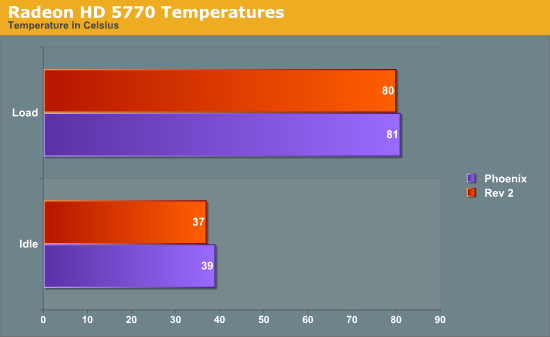
We’ll start with a look at temperatures. Our expectations for the Rev 2 cooler were for higher overall temperatures since its design means that it has to recycle some hot air rather than blowing it entirely out of computer like the Phoenix cooler does, and it’s here where we found our first surprise. Rather than being warmer than the Phoenix, the Rev 2 is cooler (if ever so slightly) in both idle and load situations. At a 2C and 1C different at idle and load respectively it’s not a huge difference, but it’s an extremely notable difference since the otherwise simpler Rev 2 cooler is clearly keeping up with and otherwise outperforming the Phoenix.
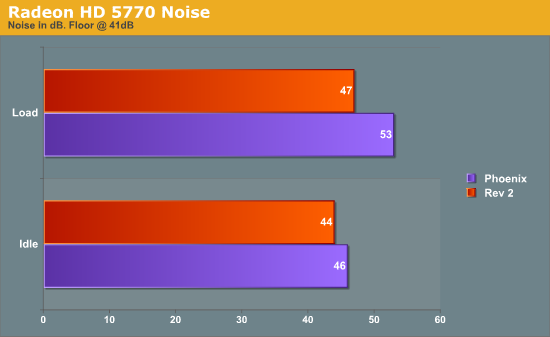
Our other surprise came in our noise tests .Surely the Phoenix would be quieter thanks to its shrouding, right? Wrong we were once again. In fact the difference is even more pronounced than the temperature differences. The Rev 2 cooler not only manages to stay quieter than the rest of the computer (something the Phoenix can’t claim) but at load the difference becomes 6dB. While the Phoenix cooler is by no means a loud cooler, the Rev 2 in comparison is whisper-silent. Even compared to itself, the Rev 2 is only 3dB louder under load than it is while idling.
Final Thoughts
Frankly, based on this data we have a hard time justifying the Phoenix over the Rev 2 cooler. The Rev 2 makes for a smaller board, a slightly cooler GPU, and a significantly quieter video card. Thusly the only advantage the Phoenix cooler has is that it completely exhausts all hot air, which in the case of our well ventilated Thermaltake case isn’t doing it any favors. Unless this card is placed in a case with extremely poor airflow, we can’t think of a situation where the Phoenix cooler is superior (and in which case, we’re left wondering whether there would be enough fresh air to satisfy the Phoenix regardless).
The Phoenix cooler may be the better looking (and 5800-series matching) cooler, but ultimately it’s not the best cooler. AMD and their partners were wise to ditch the Phoenix for the Rev 2 in most of their design, as it offers better thermal and acoustic performance, not to mention a lower resulting price (we’d peg the difference at about $10 retail). In fact at this point we’re left wondering why they launched the Phoenix at all –ultimately it would have been all the more impressive for the 5770 and cheaper for consumers if they had just launched with the Rev 2 cooler in the first place.


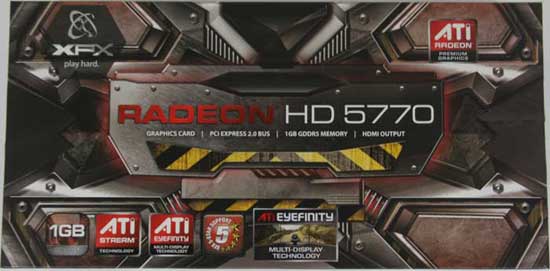
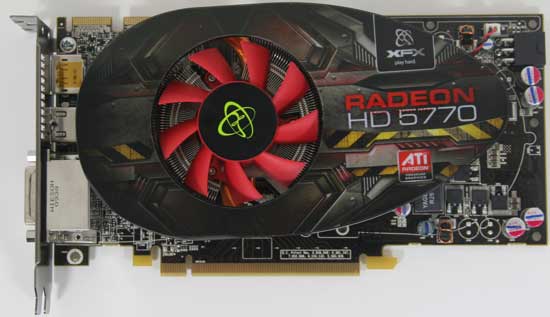








34 Comments
View All Comments
dvijaydev46 - Thursday, January 7, 2010 - link
It would have been better if the new cooler was tested after overclocking it. Anyways, my HR03 Rev A is waiting for a 5770.Herdwick - Friday, January 8, 2010 - link
If the case was well ventilated there might have been negative air pressure inside the case. Aiflow through the Pheonix fan might be reduced if it is fighting against the case and power supply exhaust fans. It would be interesting to know if the extra heat dumped into the case by the Rev2 cooler had any effect on case/CPU temps.mindless1 - Monday, January 11, 2010 - link
TYpical PC axial fans do not maintain much pressure, if it is a negatively pressurized case it isn't going to effect temperatures as much as you might suspect, particularly with the Phoenix squirrel cage (centrifugal) fan which does maintain pressure far better than axial case or PSU fans do.Issues with video cards dumping their heat into a case are mostly urban myths. IF the case ventilation is that bad, either cooler won't matter much relative to what the real problem is in the cooling subsystem.
dvijaydev46 - Thursday, January 7, 2010 - link
It would have been better if the new cooler was tested after overclocking it. Anyways, my HR03 Rev A is waiting for a 5770.jabber - Wednesday, January 6, 2010 - link
I have the MK2 cooler on my 5770 but I cant get the temps to go above 55c at full load.Most odd.
What really stresses a GPU to really give it a hard time?
AznBoi36 - Wednesday, January 6, 2010 - link
OCCT / Furmark are the best at this.marc1000 - Wednesday, January 6, 2010 - link
or runnning a game that is not CPU-bound with heavy settings on the graphics. I like DevilMayCry 4, as it runs light on the CPU (below 30%) but if I turn 4xAA it can tax the 5770 to 100% GPU utilization.in this case, on a hot day, my board will reach 77º C (this is the max I've seen on my board, but I never ran Furmark to see the absolut maximum).
anyway I've read some rummors that the Rev2 cooler will not go above 55º C on a "normal load" (running games, and not Furmark). maybe this is the case, Ryan tested with Furmark. can you please confirm it to us, Ryan? do you have a load example with a game running too?
Kaleid - Wednesday, January 6, 2010 - link
out with the old fan, and in with a 120mm fan. Just use zip ties. 800rpm should do.dukeariochofchaos - Wednesday, January 6, 2010 - link
I wonder about the phoenix on the 5800 series, do you think an aftermarket fan would work better?Also, is it possible to cram a better fan inside of the phoenix?
Kaleid - Wednesday, January 6, 2010 - link
I would get an Arctic Cooling S1 rev B. It has to be slightly modified though, have to bend the fins of the cooler a bit, which is easy.VRM cooling might be more difficult though.
A 150w card might need a 1000rpm to cool it down.. not sure. Never had above 110w